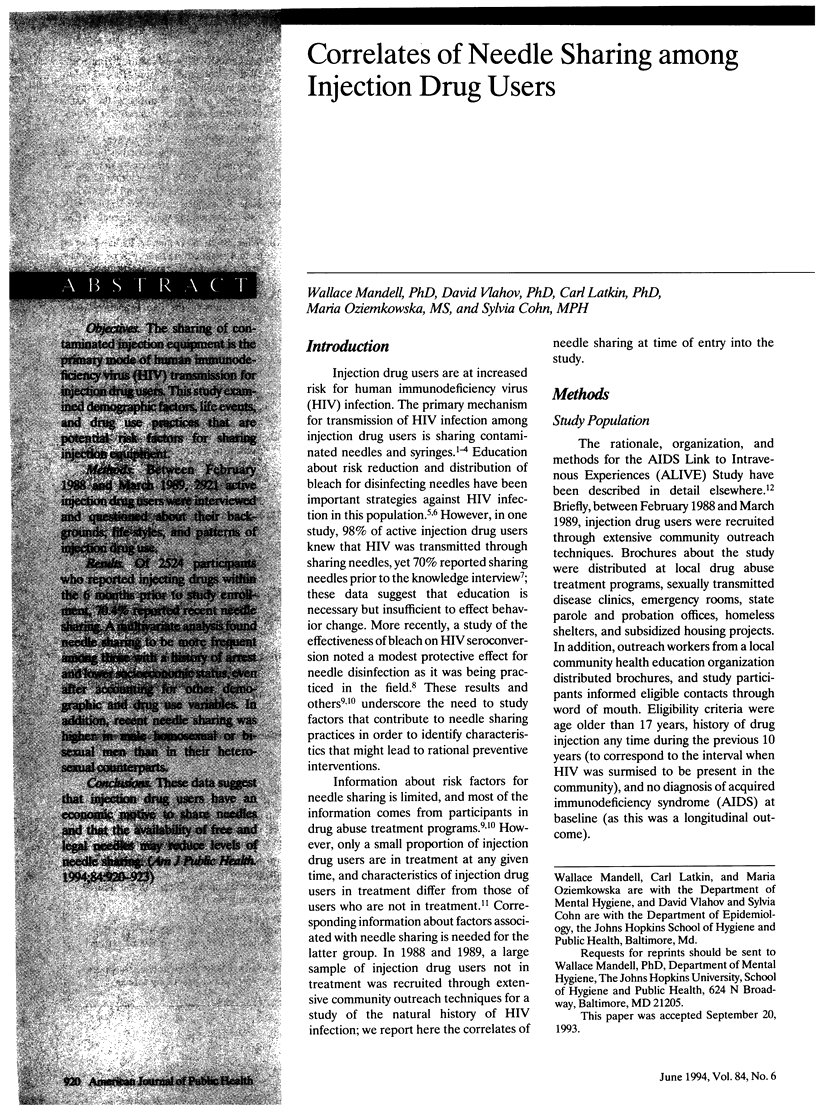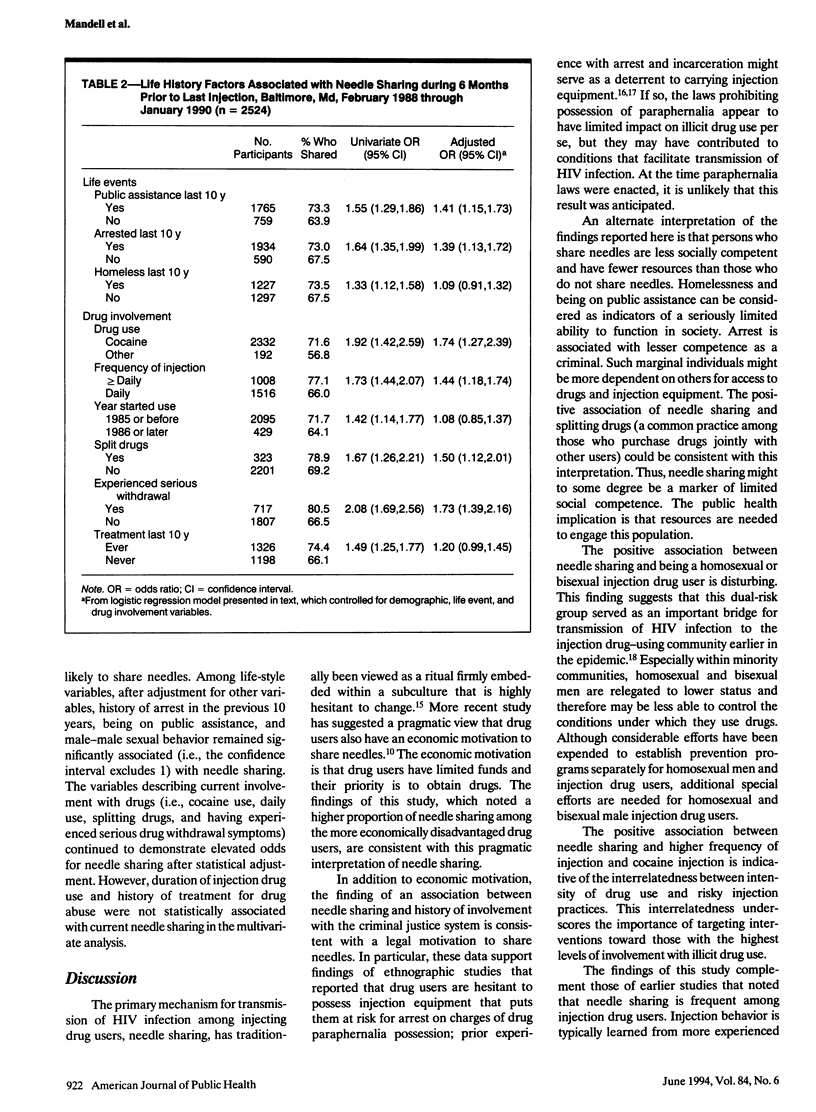Abstract
OBJECTIVES. The sharing of contaminated injection equipment is the primary mode of human immunodeficiency virus (HIV) transmission for injection drug users. This study examined demographic factors, life events, and drug use practices that are potential risk factors for sharing injection equipment. METHODS. Between February 1988 and March 1989, 2921 active injection drug users were interviewed and questioned about their backgrounds, life-styles, and patterns of injection drug use. RESULTS. Of 2524 participants who reported injecting drugs within the 6 months prior to study enrollment, 70.4% reported recent needle sharing. A multivariate analysis found needle sharing to be more frequent among those with a history of arrest and lower socioeconomic status, even after accounting for other demographic and drug use variables. In addition, recent needle sharing was higher in male homosexual or bisexual men than in their heterosexual counterparts. CONCLUSIONS. These data suggest that injection drug users have an economic motive to share needles and that the availability of free and legal needles may reduce levels of needle sharing.
Full text
PDF



Selected References
These references are in PubMed. This may not be the complete list of references from this article.
- Alcabes P., Vlahov D., Anthony J. C. Correlates of human immunodeficiency virus infection in intravenous drug users: are treatment-program samples misleading? Br J Addict. 1992 Jan;87(1):47–54. doi: 10.1111/j.1360-0443.1992.tb01899.x. [DOI] [PubMed] [Google Scholar]
- Battjes R. J., Pickens R. W., Amsel Z., Brown L. S., Jr Heterosexual transmission of human immunodeficiency virus among intravenous drug users. J Infect Dis. 1990 Nov;162(5):1007–1011. doi: 10.1093/infdis/162.5.1007. [DOI] [PubMed] [Google Scholar]
- Black J. L., Dolan M. P., DeFord H. A., Rubenstein J. A., Penk W. E., Robinowitz R., Skinner J. R. Sharing of needles among users of intravenous drugs. N Engl J Med. 1986 Feb 13;314(7):446–447. doi: 10.1056/nejm198602133140712. [DOI] [PubMed] [Google Scholar]
- Brickner P. W., Torres R. A., Barnes M., Newman R. G., Des Jarlais D. C., Whalen D. P., Rogers D. E. Recommendations for control and prevention of human immunodeficiency virus (HIV) infection in intravenous drug users. Ann Intern Med. 1989 May 15;110(10):833–837. doi: 10.7326/0003-4819-110-10-833. [DOI] [PubMed] [Google Scholar]
- Chaisson R. E., Moss A. R., Onishi R., Osmond D., Carlson J. R. Human immunodeficiency virus infection in heterosexual intravenous drug users in San Francisco. Am J Public Health. 1987 Feb;77(2):169–172. doi: 10.2105/ajph.77.2.169. [DOI] [PMC free article] [PubMed] [Google Scholar]
- Friedman S. R., Des Jarlais D. C., Sotheran J. L. AIDS health education for intravenous drug users. Health Educ Q. 1986 Winter;13(4):383–393. doi: 10.1177/109019818601300409. [DOI] [PubMed] [Google Scholar]
- Gostin L. The needle-borne HIV epidemic: causes and public health responses. Behav Sci Law. 1991 Summer;9(3):287–304. doi: 10.1002/bsl.2370090306. [DOI] [PubMed] [Google Scholar]
- Magura S., Grossman J. I., Lipton D. S., Siddiqi Q., Shapiro J., Marion I., Amann K. R. Determinants of needle sharing among intravenous drug users. Am J Public Health. 1989 Apr;79(4):459–462. doi: 10.2105/ajph.79.4.459. [DOI] [PMC free article] [PubMed] [Google Scholar]
- Marmor M., Des Jarlais D. C., Cohen H., Friedman S. R., Beatrice S. T., Dubin N., el-Sadr W., Mildvan D., Yancovitz S., Mathur U. Risk factors for infection with human immunodeficiency virus among intravenous drug abusers in New York City. AIDS. 1987 May;1(1):39–44. [PubMed] [Google Scholar]
- Powell D. H. A pilot study of occasional heroin users. Arch Gen Psychiatry. 1973 Apr;28(4):586–594. doi: 10.1001/archpsyc.1973.01750340104016. [DOI] [PubMed] [Google Scholar]
- Schoenbaum E. E., Hartel D., Selwyn P. A., Klein R. S., Davenny K., Rogers M., Feiner C., Friedland G. Risk factors for human immunodeficiency virus infection in intravenous drug users. N Engl J Med. 1989 Sep 28;321(13):874–879. doi: 10.1056/NEJM198909283211306. [DOI] [PubMed] [Google Scholar]
- Selwyn P. A., Feiner C., Cox C. P., Lipshutz C., Cohen R. L. Knowledge about AIDS and high-risk behavior among intravenous drug users in New York City. AIDS. 1987 Dec;1(4):247–254. [PubMed] [Google Scholar]
- Vlahov D., Anthony J. C., Celentano D., Solomon L., Chowdhury N. Trends of HIV-1 risk reduction among initiates into intravenous drug use 1982-1987. Am J Drug Alcohol Abuse. 1991;17(1):39–48. doi: 10.3109/00952999108992808. [DOI] [PubMed] [Google Scholar]
- Vlahov D., Anthony J. C., Munoz A., Margolick J., Nelson K. E., Celentano D. D., Solomon L., Polk B. F. The ALIVE study, a longitudinal study of HIV-1 infection in intravenous drug users: description of methods and characteristics of participants. NIDA Res Monogr. 1991;109:75–100. [PubMed] [Google Scholar]
- Vlahov D., Muñoz A., Celentano D. D., Cohn S., Anthony J. C., Chilcoat H., Nelson K. E. HIV seroconversion and disinfection of injection equipment among intravenous drug users, Baltimore, Maryland. Epidemiology. 1991 Nov;2(6):444–446. doi: 10.1097/00001648-199111000-00010. [DOI] [PubMed] [Google Scholar]


